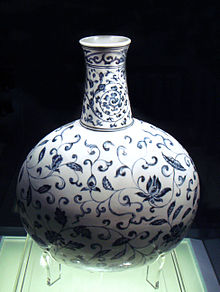
ceramic
เซรามิก (อังกฤษ: ceramic) เซรามิกมีรากศัพท์มาจากภาษากรีก keramos มีความหมายว่า สิ่งที่ถูกเผา ในอดีตวัสดุเซรามิกที่มีการใช้งานมากที่สุดคือ เซรามิกดั้งเดิม ทำมาจากวัสดุหลักคือดินเหนียว โดยในช่วงแรกเรียกผลิตภัณฑ์ประเภทนี้ว่า ไชน่าแวร์ เพื่อเป็นเกียรติให้กับคนจีนซึ่งเป็นผู้บุกเบิกการผลิตเครื่องปั้นดินเผารุ่นแรก ๆ
A ceramic is an inorganic, nonmetallic solid prepared by the action of heat and subsequent cooling. Ceramic materials may have a crystalline or partly crystalline structure, or may be amorphous (e.g., a glass). Because most common ceramics are crystalline, the definition of ceramic is often restricted to inorganic crystalline materials, as opposed to the noncrystalline glasses.
The earliest ceramics were pottery[citation needed] objects or 27,000 year old figurines made from clay, either by itself or mixed with other materials, hardened in fire. Later ceramics were glazed and fired to create a colored, smooth surface. Ceramics now include domestic, industrial and building products and art objects. In the 20th century, new ceramic materials were developed for use in advanced ceramic engineering; for example, in semiconductors.
The word "ceramic" comes from the Greek word κεραμικός (keramikos), "of pottery" or "for pottery",from κέραμος (keramos), "potter's clay, tile, pottery". The earliest mention of the root "ceram-" is the Mycenaean Greek ke-ra-me-we, "workers of ceramics", written in Linear B syllabic script. "Ceramic" may be used as an adjective describing a material, product or process; or as a singular noun, or, more commonly, as a plural noun, "ceramics".
Types of ceramic products
For convenience, ceramic products are usually divided into four sectors; these are shown below with some examples:
- Structural, including bricks, pipes, floor and roof tiles
- Refractories, such as kiln linings, gas fire radiants, steel and glass making crucibles
- Whitewares, including tableware, cookware, wall tiles, pottery products and sanitary ware
- Technical, is also known as engineering, advanced, special, and in Japan, fine ceramics. Such items include tiles used in the Space Shuttle program, gas burnernozzles, ballistic protection, nuclear fuel uranium oxide pellets, biomedical implants, coatings of jet engine turbine blades, ceramic disk brake, missile nose cones,bearing (mechanical). Frequently, the raw materials do not include clays.
[edit]Examples of whiteware ceramics
- Earthenware, which is often made from clay, quartz and feldspar.
- Stoneware
- Porcelain, which is often made from kaolin
- Bone china
[edit]Classification of technical ceramics
Technical ceramics can also be classified into three distinct material categories:
- Oxides: alumina, beryllia, ceria, zirconia
- Nonoxides: carbide, boride, nitride, silicide
- Composite materials: particulate reinforced, fiber reinforced, combinations of oxides and nonoxides.
Each one of these classes can develop unique material properties because ceramics tend to be crystalline.
Types of ceramic materials
A ceramic material is an inorganic, non-metallic, often crystalline oxide, nitride or carbide material. Some elements, such as carbon or silicon, may be considered ceramics. Ceramic materials are brittle, hard, strong in compression, weak in shearing and tension. They withstand chemical erosion that occurs in other materials subjected to acidic or caustic environments. Ceramics generally can withstand very high temperatures, such as temperatures that range from 1,000 °C to 1,600 °C (1,800 °F to 3,000 °F). A glass is often not understood as a ceramic because of its amorphous (noncrystalline) character. However, glass making involves several steps of the ceramic process and its mechanical properties are similar to ceramic materials.
Traditional ceramic raw materials include clay minerals such as kaolinite, whereas more recent materials include aluminium oxide, more commonly known asalumina. The modern ceramic materials, which are classified as advanced ceramics, include silicon carbide and tungsten carbide. Both are valued for their abrasion resistance, and hence find use in applications such as the wear plates of crushing equipment in mining operations. Advanced ceramics are also used in the medicine, electrical and electronics industries.

ไม่มีความคิดเห็น:
แสดงความคิดเห็น